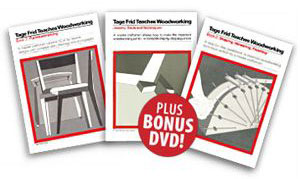
BOOK REVIEW:
Tage Frid Teaches Woodworking
, by Tage Frid
by J. Norman Reid
Delaplane, VA
Master craftsman Tage Frid (pronounced Tay) completed a five-year apprenticeship in
his native Denmark before coming to the U.S. after World War II. In this, the 100th
anniversary of his birth, I am reviewing this
classic three-volume set
that conveys much of Frid's experience. The set comprises a virtually complete course
in woodworking that combines power and hand tools to produce beautiful furniture.
Thoroughly illustrated in Black and White, Frid's clear descriptions of his work methods are laced
with gentle humor that make this set a fun as well as highly-instructive read. The set is
accompanied by a DVD that profiles Frid and allows us to get to know him as a person
and woodworker.
Book 1 is devoted to joinery. It begins with a short section on wood, then discusses
saws of all types—handsaws, circular saws, bandsaws and saw blades. Following this,
Frid considers the task of preparing stock properly by using handplanes, the jointer,
thickness planer and tablesaw.
The meat of Book 1 is Frid's discussion of joinery. He begins with dovetails—through,
half-blind, full-blind and compound miter dovetails—cut both by hand and machine.
This is followed by a section that demonstrates straight and angled finger joints, mock
finger joints, mock dovetails and a variety of splined joints. Then comes a section on
tongue and groove joints that also covers mitered joints, lock miter joints, sliding
dovetails by hand and machine and doweled joints.
This is succeeded by a section on mortise and tenon joints—again cut by hand or
machine—and another that demonstrates half lap and slip or bridle joints. Book 1
concludes with a discussion of various styles of mitered frame joints.
Each joint is clearly described and fully illustrated, so the woodworker will be readily
able to follow Frid's guidance. Frid demonstrates various jigs that will help assure
accurate results and describes how each joint can be made by both machine and hand
tool methods.
Book 2—Shaping, Veneering, Finishing—begins with steam bending wood and how to
build a steam box like Frid's for little cost. Frid follows with consideration of the steam
bending-process and the use of forms. He then turns to laminating, clamping up
laminates and creating complicated bends. A brief section on scraper blades and
cabinet scrapers follows.
Frid then turns to shaping by carving, reviewing the basic set of carving tools that will be
useful to the woodworker before demonstrating how he carved a textured bowl from a
block of wood.
Lathe work—starting with spindle turning—comes next. Frid demonstrates how to
rough out and dimension a cylinder, including off-axis and half-round turning. He then
discusses bricklaying or segmented turning.
This is followed by a long section on plywood and veneering. His discussion of plywood
reviews its manufacture, grading and materials. Most attention in this section is devoted
to veneering—including hammer veneering—a method that woodworkers who lack a
veneer press can use for small pieces such as box tops and the tops of small tables or
drawer fronts. Frid also discusses edge veneering and veneering large surfaces. A
special feature on the accompanying DVD demonstrates the use of a vacuum press for
veneering.
Frid includes a brief section on inlaying using a powered router.
The final section of Book 2 is devoted to finishing. Included subjects are surface
preparation, sanding, grain filling, staining, ebonizing and the use of oil, shellac, lacquer
and varnish. An extended section is devoted to French polishing.
Book 3—Furnituremaking—is a presentation of 18 of Frid's own favorite designs, along
with complete plans and drawings that will enable the woodworker to duplicate or modify them. The projects cover a wide range of interesting subjects, including a
drawing table, Frid's workbench, a variety of tables of differing types, several chair
styles, Frid's three-legged stool, a grandmother clock, standup desk and sideboard.
The book concludes with furniture for the office, kitchen, tambour doors and a gallery of
Frid's other furniture. Frid also describes a jig for thickness planing a wide board with a
hand-held router.
These volumes are a very practical set of instructions by a hybrid woodworker from an
era before that term came into use. What sets Frid's work apart from other books is its
completeness, depth of detail and clear descriptions. Although some machine tool
references are now slightly out-of-date, this is easily overlooked and in no way
invalidates this set's value as an instructional and reference source.
This set will be especially helpful for intermediate level woodworkers who are seeking to
expand their repertoire of working methods. Woodworkers who are relatively new to the
hobby will find these books an exploration of methods to grow into as well as an
inspiration to excel. Advanced woodworkers will get the most benefit from the wealth of
information about joinery in Book 1 and the steam-bending and veneering sections in
Book 2. Speaking for myself, I'm glad I own and have read this set, and I'll refer to it
often for help. It's a worthy addition to any woodworker's reference library.
CLICK HERE to order your copy of
Tage Frid Teaches Woodworking
J. Norman Reid is a woodworker, writer, and woodworking instructor living with his wife in the foothills of the Blue Ridge Mountains with a woodshop full of power and hand tools and four cats who believe they are cabinetmaker's assistants.
He can be reached by email at
nreid@fcc.net
.
Return to
Wood News
front page
